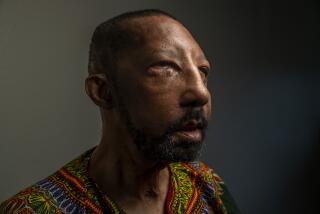First face transplant in U.S. is performed
- Share via
A woman being treated at the Cleveland Clinic has an almost entirely new face following the most extensive facial transplant ever performed, the medical center said Tuesday. The surgery was the first face transplant in the U.S. and the fourth in the world.
Few details about the patient have been released in advance of a news conference scheduled for today. About 80% of the patient’s face was replaced with skin and muscles harvested from a cadaver.
The family of the patient has asked that her name and age not be released so she can remain anonymous, the clinic said. It was not clear when the surgery took place.
Dr. Maria Siemionow, the Cleveland Clinic plastic surgeon who performed the marathon procedure, is well known among microsurgery specialists, and colleagues were quick to praise the achievement. They said face transplants would become routine in the coming years.
“We’re on the threshold of a whole new way of correcting defects,” said Dr. Warren C. Breidenbach of the University of Louisville, who performed the first hand transplant in the United States.
Siemionow and her colleagues at the Cleveland Clinic spent years preparing for the surgery, practicing on animals and doing trial runs on 20 cadavers, said Dr. James Bradley, a professor of plastic surgery at UCLA Medical Center who has seen several presentations by Siemionow at research meetings. About 50 candidate patients have been considered for the procedure.
“They’ve done their homework,” Bradley said of the transplant team.
The idea of performing a face transplant dawned on Siemionow when she was training as a hand surgeon with Breidenbach in Louisville, Ky.
Many of the patients she treated had suffered extensive injuries from burns, and though hands could be repaired and arms and torsos covered by clothes, their faces remained permanently scarred and on display, she wrote in a memoir published last year titled “Transplanting a Face.”
“Those who suffered extensive damage to their faces would forever be socially crippled in a society that appears to value beauty above all other human characteristics,” she wrote.
The first facial transplant was performed in 2005 on Isabelle Dinoire, a 41-year-old mother of two in France, after the lower part of her face was mauled by her pet Labrador. Two other individuals have received face transplants since then -- a man in France who suffered from a genetic condition and a man in China who was mauled by a bear who had attacked his sheep.
The surgery in Cleveland probably lasted six to 10 hours as surgeons painstakingly grafted the blood vessels, muscles and skin from the donor onto the patient, Bradley said. It could take months before the nerves have healed enough to gauge the success of the procedure, he added.
After the swelling subsides, the patient won’t look exactly like the donor. “You look more like a cousin” of the donor, Bradley said. “The bone structure is your own, but the skin is from another person.”
Transplanting a face isn’t any more of a technical feat than transplanting a hand, surgeons said. But a face transplant has a unique set of complications.
“You have to wait for a donor, and that’s not easy,” Breidenbach said. “A lot of donor families are in shock and grief because their loved one died and they have to donate a very visible part of the person.”
Finding the right patient is even more difficult. Candidates for the surgery at Cleveland Clinic “undergo evaluation by the most rigorous clinical and psychological examinations devised,” Siemionow wrote.
The patient’s psychological state is especially important because recovery depends most of all on a willingness to adopt a healthy lifestyle that will minimize the risk of infection, Siemionow said.
All transplant patients commit themselves to a lifetime of drugs that suppress their immune systems so their bodies won’t reject the donor tissue. Compared with internal organs such as a kidney or liver, the risk of rejection with a transplant involving skin is especially high, Bradley said.
The immunosuppressant drugs have severe side effects and could shorten a patient’s life by as much as 10 years, doctors said.
The surgery is sure to be controversial, but Michael H. Shapiro, a law professor and bioethics expert at the USC Gould School of Law, said it was easily justifiable.
“This is not Botox,” he said. “We are talking about people whose life prospects are impaired because the human race can’t handle disfigurement. That’s just a brute fact. We can try to overcome it, but in the meantime, what are these people supposed to do?”
As word spread over the last few years that the Cleveland Clinic intended to conduct a face transplant, Siemionow was touched by the outpouring of interest from patients willing to undertake such a drastic procedure.
“There is a need,” she wrote.
--
Times staff writer Mary Engel contributed to this report.
More to Read
Sign up for Essential California
The most important California stories and recommendations in your inbox every morning.
You may occasionally receive promotional content from the Los Angeles Times.











